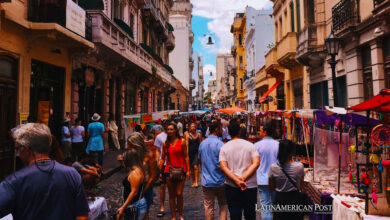Which countries in Latin America have the best investment ratings?
Risk Rating Agencies Have Modified Their Perspectives in Latin America, Creating Challenges For Post-COVID-19 Growth.

Latin America is going through a severe economic impact thanks to the health crisis caused by the COVID-19 pandemic. Photo: Pexels
LatiAmerican Post | Rafael Ricardo Lopez Marti
Listen to this article
Leer en español: ¿Qué países de Latinoamérica tienen las mejores calificaciones de inversión?
Latin America is going through a severe economic impact thanks to the health crisis caused by the COVID-19 pandemic because the trend points towards the reduction of value chains and the complete devaluation of international investment. However, the outlook is very uncertain and only depends on how long covid's repercussions extend.
You may also be interested in: Latin America: cities for entrepreneurs
Several rating agencies have shown in their studies a comprehensive analysis of the broad coverage of emerging markets in the 2021 economy, including S&P Global Ratings, Fitch Ratings Global, and Moody's Investors Service. In addition, there is the investigation and the newsletters of Marsch Specialty, in its Political Risk Map 2021, in which it mentions the economic risk and the keys that Latin America must-have for its speedy recovery. All the studies lead to an increase in disparity linking emerging economies and as a consequence indebtedness with various negative circumstances that fall on public and private companies.
Investment Ratings Of Latin American Countries
Some data from the aforementioned studies show their investment rating by country, ranking the best and worst in Latin America.
The best investment ratings
Chile
The rating agencies S&P Global Ratings, Global de Fitch Ratings and Moody's Investors Service, give Chile a rating of A, A- and A1 respectively, which means that there is a higher average grade in investments in that country. However, they differ in degrees from one to the other.
Peru
The rating agency S&P Global Ratings gives Peru a rating of BBB +, which means that there is a lower average rating in the country. Subsequently, the Fitch Ratings Global rating agency grants it BBB +, the same merit as S&P Global, and finally, in the case of the Moody's Investors Service rating agency, it grants the rating of A3, a few degrees above the other analyzes.
Uruguay – Panama – Mexico
The rating agencies S&P Global Ratings, Global de Fitch Ratings and Moody's Investors Service, grant Uruguay, Panama and Mexico the same ratings of BBB, BBB- and Baa2 respectively, which means a lower average grade.
Brazil
The rating agency S&P Global Ratings gives Brazil a BB- rating, which means that there is a degree of speculative non-investment in the country. Subsequently, the Fitch Ratings Global rating agency gives it BB-, the same appreciation as S&P Global, and finally, in the case of the Moody's Investors Service rating agency, it is awarded the Ba2 rating, a lower grade than the previous rating agencies.
The Worst Investment Ratings
Argentina
The rating agency S&P Global Ratings gives Argentina a CCC + rating, which means that there is a substantial risk to invest in that country. Next, the Fitch Ratings Global rating agency gives it CCC, the same appreciation as S&P Global, and finally, in the case of the Moody's Investors Service rating agency, it grants it Ca, an extremely speculative category.
Venezuela
The rating agencies S&P Global Ratings and Moody's Investors Service, grant Venezuela a rating of B- and C respectively, which means that said country is highly speculative for investments. However, the Fitch Ratings Global rating agency gives it WD, which means that it is in default, placing it in a worse category.
All studies agree, with respect to Colombia
S&P Global Ratings
The S&P Global Ratings study found a GDP increase of 6%, since during 2020, Colombia had one of the worst performances in Latin America, due to the fact that the demand for oil plummeted during the pandemic. However, it is expected that there will be a notable recovery in 2022. This, obviously added by the fall of the Tax Reform that the Government of Iván Duque intended to approve and thus calm the markets. Duque had to withdraw his first proposal due to the great rejection of the population that ended in innumerable social protests that resulted in dozens of deaths, human rights violations and months of blockades. Now the Colombian government hopes to be able to pass a new, much less ambitious reform. The rating agency that most recently downgraded Colombia was Fitch, following in the footsteps of S&P.
S&P Global Ratings actualizó sus perspectivas sobre el comportamiento del #PIB para Colombia ,la economía colombiana va a caer 7,8 % este año (vs 8 % estimación anterior) y para 2021 prevé un crecimiento del 5,1 % (vs el 5,5 % estimación anterior.) pic.twitter.com/6MQRn5MKbW
— Datoeconomia (@datoeconomia) December 7, 2020
Moody's Investors Service
On the contrary, the score of Colombia will be checked again at the end of 2021, by Moody's Investors Service regarding the fiscal issue and the tax reform to verify its performance, since not only debt is measured over GDP, The influence of the behavior of the economy also wieghs on the score, according to the Moody's Investors Service study.
#16Dic/ De acuerdo a las perspectiva 2021 para las industrias de petróleo y gas de Moody's Investors Service, el panorama para el sector en general es estable, sin embargo, para el caso #Venezuela es negativa, si no hay un cambio político y económico que privilegie el desarrollo. pic.twitter.com/El8yzuw1Ok
— Soy Gente del Petróleo (@soygdelpetroleo) December 16, 2020





